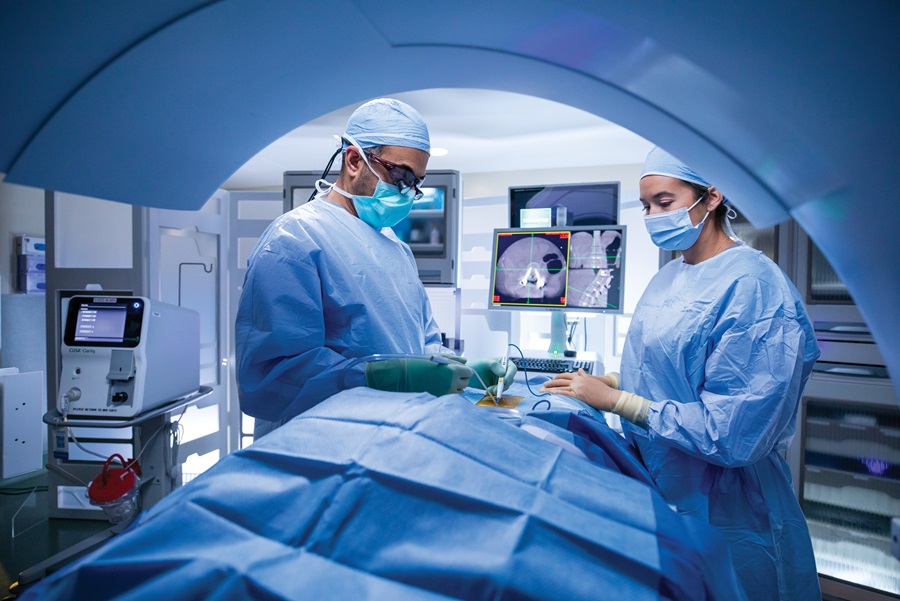Networking with the Best Spine Surgeons in St Louis MO for Comprehensive Care
Networking with the Best Spine Surgeons in St Louis MO for Comprehensive Care
Blog Article
An Introduction of Spine Problems That Frequently Cause Surgical Treatments
Spinal column conditions such as herniated discs, back stenosis, and degenerative disc condition often necessitate medical treatments when conventional treatments fall short to minimize consistent signs. These problems not just cause significant discomfort however can also seriously harm daily performance and general quality of life. Understanding the nuances of each problem and the matching surgical alternatives, such as discectomy or back fusion, is critical for effective management. As we check out these conditions additionally, it comes to be apparent that the decision-making process surrounding medical therapy is complex and warrants cautious factor to consider.
Herniated Discs
Although many individuals with herniated discs may locate alleviation with traditional therapies, surgical procedure comes to be a necessary consideration when symptoms linger or get worse - best spine surgeons in st louis mo. A herniated disc takes place when the soft inner gel of a spinal disc sticks out with its external layer, potentially pressing nearby nerves and leading to pain, tingling, or weak point in the extremities
Conservative administration commonly includes physical therapy, pain medications, and corticosteroid injections, which intend to lower inflammation and enhance function. Nevertheless, in situations where these methods fall short to ease incapacitating signs, surgical options may be checked out.
The most common surgery for herniated discs is a discectomy, which includes the elimination of the herniated part of the disc to eliminate stress on the affected nerve origin. In extra extreme situations, spine combination may be needed to support the influenced vertebrae.
Patients are recommended to go over the possible threats and advantages of surgery with their healthcare company to make a notified choice. Inevitably, the objective of any type of medical treatment is to bring back function, minimize pain, and enhance general lifestyle for people dealing with herniated discs.
Back Constriction
Spine stenosis occurs when the spaces within the spine slim, bring about raised stress on the spine cord and nerves. This condition can develop in numerous areas of the spinal column, including the cervical and lumbar locations, usually as a result of age-related modifications, such as degenerative disc illness, arthritis, or thickening of tendons.
Individuals with spine stenosis may offer with signs and symptoms that include pain, numbness, prickling, or weakness, primarily in the arms or legs. These signs can be intensified by activities that entail standing or walking, frequently leading people to look for relief via conventional treatments like physical treatment, medications, or epidural steroid shots.
However, when these non-surgical interventions fail to give adequate relief, medical choices may be taken into consideration. Typical procedures for back stenosis consist of laminectomy, which involves the elimination of part of the vertebra to alleviate pressure, and back combination, which maintains the afflicted location. The decision to go after surgery is commonly based on the extent of symptoms, the degree of functional disability, and the total health and wellness of the person. Prompt medical diagnosis and management are vital to avoid more neurological concession and improve lifestyle.
Spondylolisthesis
Spondylolisthesis takes place when one vertebra slips forward over one more, causing imbalance of the back. This problem can result from various elements, including hereditary flaws, injury, or degenerative adjustments in the back. It is most generally observed in the back region, specifically at the L4-L5 and L5-S1 levels.

When non-surgical methods fall short to ease signs and symptoms or when significant nerve compression is existing, medical intervention might be warranted. Surgical choices can consist of spinal combination or decompression treatments, aimed at restoring placement and reducing neurological signs.
Degenerative Disc Condition

The condition can be detected via a combination of medical assessment, imaging studies, and patient background. When these techniques stop working to provide ample alleviation, surgical treatments may be considered.
Surgical alternatives for DDD may consist of spine blend or man-made disc replacement, focused on stabilizing the impacted segment and easing pain (best spine surgeons in st louis mo). Inevitably, the choice of therapy is individualized, considering the severity of the condition, person health, and lifestyle aspects
Spinal Growths

What elements add to the growth of lumps within the spine, and how do they materialize in individuals? Back lumps can occur from different aspects, consisting of hereditary proneness, ecological impacts, and pre-existing medical conditions. They can be categorized as primary tumors, coming from the spinal column, or additional growths, which spread from various other areas of the body. Individuals may present with a series of signs, including localized pain, neurological shortages, weakness, or changes in directory bowel and bladder function, depending on the tumor's dimension and area.
Diagnosis usually includes imaging studies such as MRI or CT checks, which assist define the tumor's features and effect on surrounding structures. In analyzing therapy choices, the tumor's kind, grade, and location are vital considerations. Surgical treatment may be necessitated to relieve signs, obtain a biopsy, or eliminate the tumor totally. The goal of surgical procedure is commonly to decompress neural components and stabilize the back. Adjuvant therapies, consisting of radiation or radiation treatment, might also be essential depending upon the lump's nature. Early detection and treatment are essential for maximizing results in patients with spine tumors.
Conclusion
In summary, back problems such as my latest blog post herniated discs, spinal stenosis, spondylolisthesis, degenerative disc illness, and back lumps frequently require medical treatment as a result of their potential to cause considerable discomfort and useful impairment. While conservative treatments may use short-lived relief, surgical options become vital when signs linger or aggravate. Prompt medical diagnosis and treatment play a critical duty in restoring function and enhancing the high quality of life for afflicted individuals, highlighting the significance of detailed spine care.

Report this page